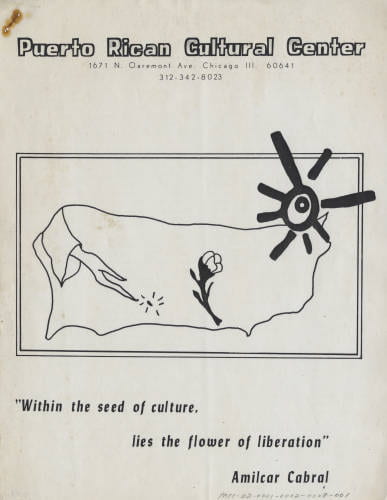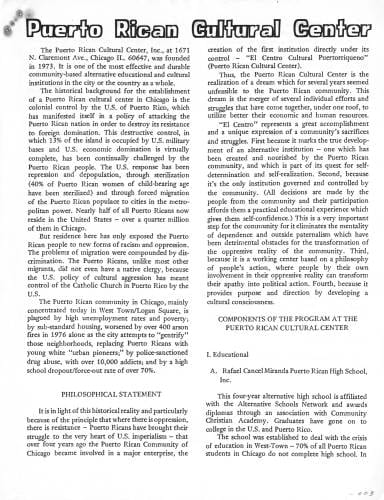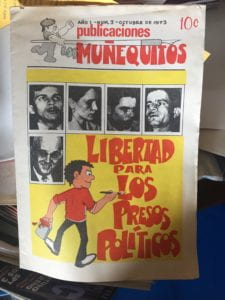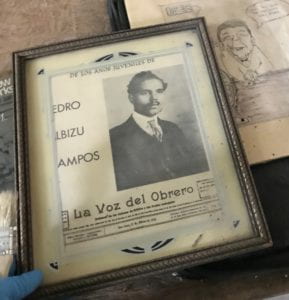In my earlier research on the history of the Puerto Rican Cultural Center and the Humboldt Park neighborhood, I focused more on the migration of Puerto Ricans from the island to the city of Chicago, and then the community’s subsequent marginalization and displacement from multiple neighborhoods throughout the decades of the latter 20th century. Due to an increased concentration of Puerto Ricans in Humboldt Park and its near-by neighborhoods on the western and northwestern side of Chicago, it is now one of the most significant centers of the Puerto Rican diaspora. While the community consistently faces and fights against further displacement from encroaching gentrification, the PRCC serves as a hub for local activism, focusing on stabilizing and maintaining a Puerto Rican identity here. Some of this work is based in cultural projects, or creating safe and active youth spaces, or focusing on healthcare, housing, and education initiatives.

Puerto Rican Cultural Center description, leaflet page 1. Year uknown. From the Puerto Rican Cultural Center Collection, Special Collections and University Archives, University of Illinois at Chicago Library.

Puerto Rican Cultural Center description, leaflet page 2. Year unknown. From the Puerto Rican Cultural Center Collection, Special Collections and University Archives, University of Illinois at Chicago Library.
The PRCC also has a hand in forming local partnerships that encourage economic and social growth through Puerto-Rican-owned businesses and commerce on Paseo Boricua, the heart of the community along Division Street, west of Western Avenue. It is also important to note that place and space factor significantly into the PRCC’s work against gentrification and towards strong community-building, and so Paseo Boricua is visually anchored by two 59-foot-tall gateway flags of Puerto Rico which helps to “forge a powerful and resistant Puerto Rican identity in Humboldt Park.”[1]

“Libertad para los Presos Politicos” (Freedom for Political Prisoners); much of the PRCC’s organizing work and historic material relates to this important movement.
While I knew that the PRCC was also significantly involved in the political struggles for Puerto Rican independence, I was recently able to participate in a short educational session and discussion with Jose E. Lopez, the organization’s Executive Director. I had already been learning about the larger issues of Puerto Rico’s political status as a colony underneath the United States, and how colonialism relates to challenges of identity. But Jose gave our group, which is working to build an archive of the PRCC’s vast records and materials as the basis for a larger community history project, an even deeper framework for understanding the founding of the PRCC as part of a Nationalist movement. Within the context of the Cold War throughout the 1950s, 60s and 70s, struggles for national liberation from colonial entities were happening globally; inspired by these movements, Jose framed the creation of the PRCC within the answer to the question, “Are Puerto Ricans a national minority in the United States, or are they of a separate Puerto Rican nation?”

One document among thousands in the archival survey we are beginning, featuring Pedro Albizu Capmos, an early leader in the movement for Puerto Rican Independence.
The PRCC, also through analyzing conditions of class and race and being inspired by a liberation theology, determined that Puerto Ricans must fight external and internalized colonialism in order to assert their humanity with self-determination, self-actualization, and self-reliance, which are still the tenets of the organization and the Independence movement today.
[1] Rachel Rinaldo, “Space of Resistance: The Puerto Rican Cultural Center and Humboldt Park,” Cultural Critique 50 (2002), 165.

“An illustration, “El Grito de Lares” with text about the Puerto Rican independence movement in 1868 featured on the back page of the publication, La Patria Libre.” From the Puerto Rican Cultural Center Collection, Special Collections and University Archives, University of Illinois at Chicago Library.

I love seeing these primary documents! It looks like you’ve had a chance to visit the UIC archives and get a sense of what they have vs. what DePaul might have and what the PRCC still has. If by the end of the summer you’re only able to map what items are where, you will have given the PRCC a tremendous push toward organizing its community archive. It’s great that you’ve had a chance to meet with Jose Lopez and find at least one scholarly resource that describes the significance of the PRCC in the context of anti-colonial activism. One thing that resonates a lot with me is the continued reference to self-reliance and self-determination, which exist in Puerto Rican organizations in New York as well. You might want to reach out to Dylan or Jesse to learn whether this kind of language plays a part at the Loisiada Center.